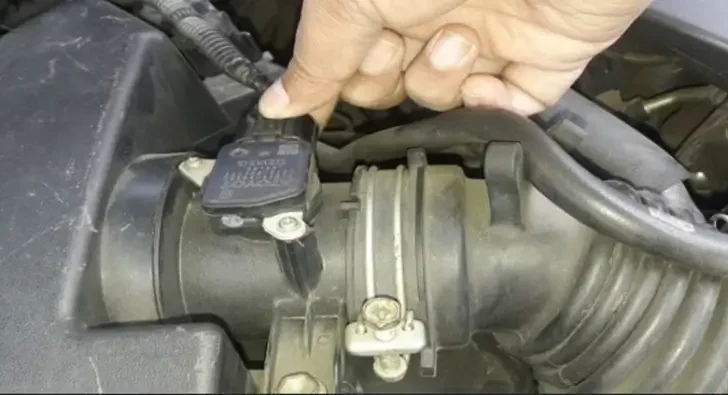It’s a fact that deposits form in every fuel system but the amount and how quickly they form depend on the quality of fuel, the oil used, personal driving styles, and engine type.
Some engines are particularly prone to wrap and buildup of fuel deposits because they’re never cooled or washed with fuel.
Carbon deposits can form in as few as five thousand to ten thousand miles causing restricted airflow and increased engine operating temperatures. So, here is how to clean the intake valve without removing it:
Key Takeaway
- To clean the intake valve without removing it, you can use a specialized intake cleaner spray and spray past the MAF sensor and directly into the intake valve.
- Intake valves are components in a car’s engine that control the flow of the air-fuel mixture into the combustion chambers, playing a crucial role in the combustion process and overall engine performance.
What Are Intake Valves
Intake valves are essential components of a car’s engine. They are responsible for allowing the air-fuel mixture to enter the combustion chamber from the intake manifold.
The intake valves open and close in synchronization with the engine’s camshaft, ensuring the proper flow of the air-fuel mixture into the cylinders.
These valves play a crucial role in the combustion process, as they determine the amount of air and fuel that enters the combustion chamber for each cycle.
By controlling the intake of this mixture, the intake valves contribute to the engine’s power output, fuel efficiency, and overall performance.
How To Clean Intake Valve Without Removing It

- Wear protective glasses and gloves
- Get the engine to operating temperature
- Remove the air filter cover
- Locate the MAF sensor
- Rev the engine to approx 2000 RPMs
- Insert the cleaner straw past the MAF sensor
- Spray the intake cleaner
- Rev the engine to approx 3500 RPMs
- Re-assemble the air intake system
1. Wear protective glasses and gloves

This is an obvious thing since safety is always number one. In order to safely clean the intake valve without removing it, please wear protective glasses and gloves.
The cleaning product is applied with the engine running and you do not want to burn your hands or risk any fluids from the running engine getting into your eyes. (See some gloves and glasses on amazon.com).
2. Get the engine to operating temperature

In order to clean the intake valve without removing it, you have to start your engine and get it at operating temperature. Most engines operate at 195 to 220 degrees Fahrenheit.
A great way to know that your engine is at its operating temperature is by looking at the temperature gauge on the dashboard.
Once the temperature gauge is in the middle between C (cold) and H (hot) that’s how you know that your engine has reached its operating temperature.
3. Remove the air filter cover

The air filter has a plastic cover that has to be removed in order to get access to the MAF sensor. The air filter cover is located near the engine and has a duct that travels from the front of the car into the engine.
To remove the air filter cover, you need to loosen the hose clamps on each side and remove any wing nuts (if present). Make sure that you don’t lose any of the parts because you will need to reassemble the air filter cover later.
While you are at it, you can check the condition of the air filter and replace it or clean it if necessary. I always recommend changing the air filter with a brand new one because they are not that expensive (check prices on air filters on amazon.com).
4. Locate the MAF sensor

The MAF sensor is a part of the electronic fuel injector system and has a function to calculate the amount of air that is entering the engine. The combustion that occurs in the combustion chamber has to have a specific air-to-fuel ratio, otherwise, the vehicle will run rich or poor. The mass airflow sensor is in charge of the air intake.
The mass airflow sensor, also known as the MAF sensor is usually located between the airbox and the throttle body. It is important to locate the MAF sensor because you are going to spray the valve intake cleaner past the MAF sensor.
5. Rev the engine to approx. 2,000 RPM

For this step, it’s best if you have someone behind the steering wheel that will be able to rev the engine to approx. 2,000 RPMs. Revving your engine to approx. 2,000 RPMs will get the engine running and will speed up the combustion process.
6. Insert the cleaner straw past the MAF sensor

This is an important step. You should only spray the cleaning product after the MAF sensor. If you spray the cleaning product in front of the MAF sensor, you will see a check engine light on your dashboard.
If you have an OBD Scanner (see prices on amazon.com), you will be able to scan your vehicle for error codes. Usually, the error code associated with the mass airflow sensor is P0102. Since you will know what caused the error code, you could go ahead and remove it.
7. Spray the intake cleaner
With the engine running at approx. 2,000 RPMs, go ahead and spray the intake cleaner (see the price on amazon.com) in 30-second intervals until the can is empty. If you feel that the engine is beginning to stall, press the gas pedal but do not exceed 3,500 RPMs.
The spray cleaner will be able to remove a lot of the carbon deposits that accumulate on the intake valves. It is important that you pay attention to where you are spraying the intake cleaner.
Some vehicles have intake manifolds designed in a way that will allow the intake cleaner to ”pool” in one place. What could happen next is when you are driving down the road, the intake cleaner could end up past the valves and trigger error codes on your dashboard.
8. Rev the engine up to 3,500 RPMS
When the intake cleaner can is empty, accelerate the engine 2-3 times over 2,000 RPMs, but again do not exceed 3,500 RPMs. Run the engine idle for one minute and then turn off the engine.
9. Re-assemble the air intake system
After you are done with spraying and revving your engine, it is time to reassemble the air intake cover. While you are at the air intake filter, inspect it and replace it if needed.
Then, turn the engine off and lead the engine head-soak for an hour. This will allow the intake cleaner to really clean the intake valves from the carbon deposit. Once one hour passes, drive your vehicle at highway speeds for at least 10 minutes. At this point, you should have clean intake valves .
Signs of Clogged Intake Valves
- Reduced engine performance and power
- Rough idling or stalling
- Increased fuel consumption
- Difficulty starting the engine
- Decreased acceleration and poor throttle response
- Engine misfires or hesitation
- Excessive exhaust smoke
- A strong smell of exhaust gases inside the vehicle cabin
- Overheating of the engine
- Check engine light illuminated on the dashboard
Causes of Clogged Intake Valves
- Carbon buildup from incomplete combustion
- Engine oil contamination
- Fuel additives or low-quality fuel
- Improper maintenance and infrequent oil changes
- Driving in stop-and-go traffic or constantly low speeds
- Short trips that do not allow the engine to reach optimal operating temperature
- Exhaust gas recirculation (EGR) system malfunction
- Faulty catalytic converter or muffler
- Engine coolant leaks into the combustion chamber
- Worn or damaged valve seals or guides
How Often Should You Clean The Intake Valves
Generally, it is recommended to clean the intake valves every 30,000-50,000 miles or at least once every other oil change for higher mileage vehicles.
If you experience problems like hesitating or stalling when the car is cold or during warm-up, or if your car has accumulated over 50,000 miles, it may be a good idea to consider cleaning the intake valves.
However, it is important to consult your vehicle’s manufacturer guidelines or seek professional advice for specific recommendations tailored to your car model and engine type.
FAQs
Q: What is the best way to clean intake valves without removing them?
A: The best way to clean intake valves without removing them is to use a valve cleaner spray specifically designed to dissolve carbon deposits. It is a relatively easy and convenient method that can improve engine performance.
Q: Can I clean exhaust valves without removing the cylinder head?
A: Yes, it is possible to clean exhaust valves without removing the cylinder head. You can use a valve cleaner spray or a specially designed cleaning tool to clean the valves through the intake or exhaust ports.
Q: How do I clean intake valves without removing the intake manifold?
A: Cleaning intake valves without removing the intake manifold can be done by using a valve cleaner spray. You can simply spray the cleaner into the throttle body or air intake while the engine is running.
Q: What is the purpose of cleaning intake valves?
A: Cleaning intake valves is important to remove carbon deposits and gunk that can build up over time. This buildup can affect engine performance and fuel efficiency. Regular cleaning helps maintain optimal engine operation.
Q: Can I clean intake valves with just a wire brush?
A: While a wire brush can help remove some deposits on intake valves, it may not be sufficient to clean them thoroughly. It is recommended to use a valve cleaner spray or a specialized cleaning tool for more effective results.
Q: How often should I clean the intake valves?
A: The frequency of cleaning intake valves depends on various factors, such as driving conditions, fuel quality, and engine type. Generally, it is recommended to clean the intake valves every 30,000 to 60,000 miles or as specified in the vehicle’s maintenance schedule.
Q: Can cleaning intake valves improve fuel efficiency?
A: Yes, cleaning intake valves can improve fuel efficiency by ensuring proper airflow and fuel mixture into the combustion chamber. Clean valves allow for better combustion and optimize engine performance.
Q: Will cleaning the intake valves solve rough idle and misfire issues?
A: Cleaning the intake valves can help solve rough idle and misfire issues if the cause is carbon buildup on the valves. However, it is important to diagnose the exact cause of the problem before attempting any repairs or maintenance.
Q: Is there a risk of damaging the valves while cleaning them?
A: When done correctly and using appropriate cleaning methods, there is minimal risk of damaging the valves while cleaning them. It is important to follow the instructions provided with the valve cleaner spray or consult a professional if unsure.
Q: Can I clean intake valves on direct injection engines?
A: Yes, it is possible to clean intake valves on direct injection engines. However, direct injection engines are more prone to carbon buildup on the intake valves due to the lack of fuel washing over them. Regular cleaning is recommended to maintain optimal engine performance.
In Conclusion
Cleaning your intake valve without removing it is an easy and cost-effective way to ensure your engine remains in top condition.
By using the right tools, such as compressed air and carburetor cleaners, you can quickly clean the intake valve without having to remove it from its housing.
